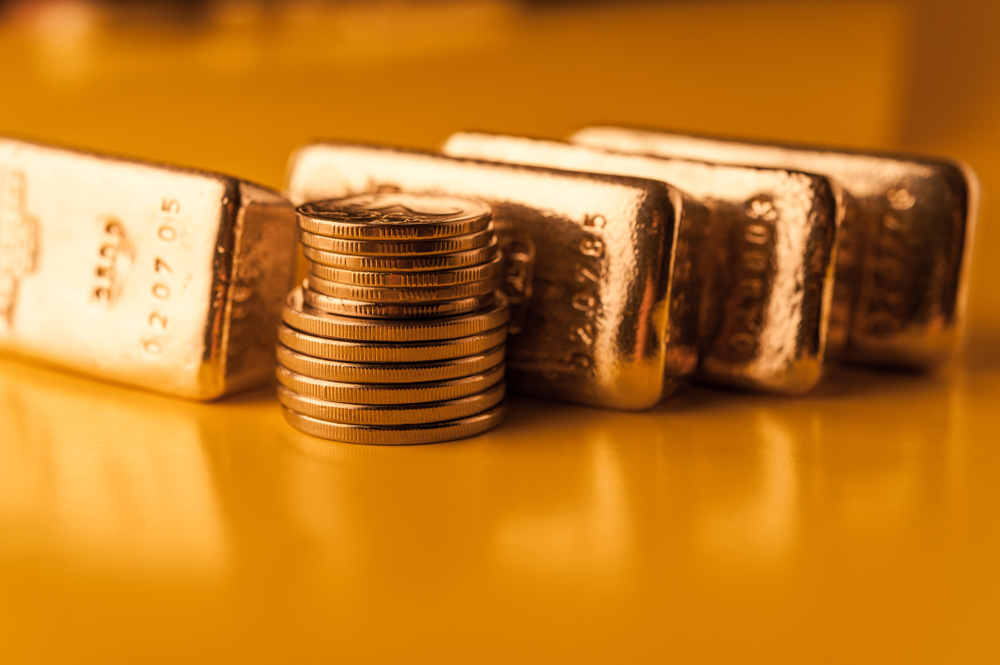
Different Types of Gold
Gold, the de facto king of precious metals, has charmed humans for centuries with its inherent value and shimmering looks. The intrinsic worth has served as a value store, a medium of exchange, and a haven in economic uncertainties. While gold is admired universally, its applications and forms are diverse. From glistening yellow gold, representing tradition and luxury, to white gold, which depicts modern allure and aesthetics, the different gold types represent quite a broad spectrum.

The various gold types are not just the color; there’s also shapes and the overall makeup. For instance, gold jewelry and gold coins are not the same. They don’t look the same, weigh differently, and likely have different quantities of gold. Each type has its appeal, depending on cultural tastes, design likelihood, and personal preferences.
Table of Contents
This article will explore the various gold dimensions, unearthing the colors’ secrets, cultural significance, and compositions. We will also touch upon gold’s malleability, corrosion resistance, the dichotomy that 24K gold is, etc. We shall particularly focus on the following:
- Physical gold and its various forms
- Paper gold and its different avatars
- A deep dive into gold alloys, a popular version of retail gold
- Answers to key questions on the topic, and more
Read more: What Are Gold Options
If you ever wanted a complete lowdown on gold and its various types and forms, continue reading this article.
Physical Gold

The first thing that hits people’s thoughts when they talk about gold is the metal itself. The physical metal can be broadly classified as bullion and jewelry.
Bullion
Bullion gold is the purest version and is usually available in coins or bars. Bullion gold usually caters to precious metal investors and collectors. A gold bar is brick-like in shape and can be of different sizes. The sizes can be as small as a few grams to bars weighing several pounds. The brick design makes the bars easy to store. Both governments and private firms make gold bars. To check gold bar authenticity, ensure it has recognized stamping and hallmarks, such as the refiner’s name, registration number, and weight and purity information.
Gold coins are the more popular bullion type. They are smaller, more pocketable, and not generic like bullion bars. They have intricate designs and stories behind them, making them more collector-friendly. Coins also have denominated values, which bars do not. Their compact size and increased recognition render gold coins more liquid or easier to trade. Storing and transporting coins is more convenient than bullion bars due to their size. Bars are usually 24-karat gold pieces. Gold coins could be less pure—for instance, the 22-karat (or 91.67 percent pure) South African Gold Krugerrand.
(Karats denote gold purity. To learn more about the gold karatage system and how it’s different from “carats,” read our comparison article.)
Note that the add-on attributes gold coins come with are not free. Additional costs are attached to the coin design and production. As the size decreases, production costs increase because carving the designs on a smaller canvas is much more labor-intensive. Minting costs don’t go up with coin size, meaning larger coins have a greater margin. Besides making costs, coins usually carry a premium, which could vary with the specific coin. Some could be highly rare and collectible, driving their values behind gold spot prices.
Jewelry
Jewelry is the more popular form of solid gold. It comes in different colors and karats. “Karats” determine the gold content of the jewelry. Unlike gold bullion, gold jewelry is usually not entirely gold. Gold is a soft metal and can easily bend or scratch. The malleability doesn’t bode well for gold jewelry's intricate designs and shapes. Therefore, other more rigid metals are added to it, such as copper, titanium, manganese, nickel, iron, etc., to make it stronger and more durable. Pure gold jewelry is a rare phenomenon and is not suited for everyday wear.
Gold-Plated Jewelry
Gold-plated jewelry is a base metal coated by a thin gold layer. The coating process is called “electroplating.” It entails cleaning the core metal (copper, nickel, or brass) and placing it in a solution containing gold ions. The liquid is later subjected to an electric current, causing the ions to bond with the base metal’s surface. The layer of gold used is skinny, between 0.175 and 2.5 microns. The gold in plated jewelry typically represents less than 0.05 percent of the item’s total weight.
Gold-Filled Jewelry
Also called a gold overlay or rolled gold, gold-filled jewelry comprises a base metal (mostly brass) covered with a coating of gold. The gold layer is thicker than gold-plated jewelry, making it long-lasting and more durable. Gold-filled jewelry’s weight should be at least 5 percent of its total weight. The gold is mechanically attached to the underlying metal using pressure and heat, resulting in an everlasting bond between the metals and making it more durable than plated jewelry.
Gold Vermeil Jewelry
Gold vermeil jewelry is an upgraded version of gold-plated jewelry. There are fundamentally two differences. The base metal is silver, and the coating must be at least 2.5 microns thick. Besides the thick gold plating and base metal difference, the cleaning and plating process is identical to gold-plated jewels. Note that the gold coating used in all three types could be 24-karat pure gold or a gold alloy as low as ten karats. Alloying pure gold will mean more prices than a plating that isn’t a solid layer of gold or has less gold.
Paper Gold
Paper gold is a digital gold investment or gold purchase that doesn’t result in the ownership of the yellow metal. It can be categorized as the following:
Gold Stocks
Gold stock is the first thing people who don’t want to buy gold but want exposure to the metal in some way opt for. A gold stock functions like any other stock. The unique thing is that it belongs to a company in the gold business in some form. Gold stocks of gold mining firms are a common example. The value of a gold stock not just sways with gold price movements but also depends on the performance of the firm that the stock belongs to.
Gold Funds
A gold fund offers exposure to gold. It could be a mutual fund or ETF invested in different gold-related assets, which include gold mining firms or other securities related to gold. A gold fund is a broader asset compared to a gold ETF. A gold fund could be invested in firms producing, exploring, or processing gold. In short, gold funds are much more diversified and complex than gold ETFs.
Gold ETFs
Gold ETFs (exchange-traded funds) are ETFs tied to physical gold. They expose the buyer to gold prices without buying physical gold. A gold ETF tracks gold prices. It’s traded on the stock market like stocks. Gold ETFs are invested in physical gold bars. They could also own contracts (such as gold futures) representing physical gold. The ETF’s price is tied directly to the gold's value.
Gold ETFs are preferred by investors who want to invest in physical gold but do not deal with the storage, insurance, and security requirements. A gold ETF is easier to sell and purchase than physical gold. It differs from stocks as gold shares of companies are not directly tied to gold and its prices. To learn more about gold ETFs, click here.
Gold Futures
A gold future is an agreement that lets investors trade (buy or sell) specific quantities of gold at set prices in the future. The future date is predetermined to facilitate the fulfillment of the contract. Gold futures offer companies in the gold industry a method to hedge gold price risks on expected future sales or purchases of gold. Firms that make gold articles could buy gold futures to arrest the metal’s prices.
The gold contract also lets investors partake in a convenient and simple means of gold investing. Gold futures are primarily used as anti-inflation hedges. Consider buying gold futures if you fancy speculating on gold prices and benefiting from the activity. Generally, gold futures trading prices are significantly lower compared to physical gold’s trading value. Futures contracts are typically sold in particular sizes, and the trading period is locked in too. You can open or close an agreement only during those times.
Gold Alloys
A gold alloy is gold mixed with other metals. Since gold is soft and ductile by nature and cannot be used to make jewelry and bullion coins by itself, other metals are added to lend the necessary hardness, durability, and also color. The non-gold metals are chosen based on the desired properties and color of the jewel. For a yellow-gold look, copper and zinc are usually added. Rose or pink gold is a mix of gold and copper.
What is the Gold Karat System?
The karat system cannot be just mentioned in the passing when discussing gold alloys. The term “karat” is a measure of gold purity. Karat is defined as a unit of 24 parts. One karat is, therefore, the lowest number, and 24 gold karats is the maximum. For a gold article to qualify as gold, it should be at least 10 karats. In some regions outside the U.S., however, the minimum is eight karats (33.3 percent pure gold).
The common gold alloys are between 14k and 18k gold (58.3 and 75 percent, respectively). They represent the correct mix of gold and rigidity. Anything lower or higher will be a compromise on either front. For example, 22-karat gold could be too soft for elaborate jewelry, such as necklaces. The alloy is best suited for rings. Conversely, ten or even 12 karats could be too little gold for one’s liking.
How are Gold Alloys Made?
A gold alloy could be created through “diffusion bonding.” The mechanical bonding process entails heating and pressing metals with each other until fusion. The output is a strong and malleable material. Gold alloy-making is a vast topic. Anyway, here is a brief introduction to the different gold alloy types.
Yellow Gold
Bright yellow is gold’s actual color. But not everything yellow is real gold, especially when it’s not deep orangey. The bright gold could be a mix of gold and other metals, such as copper, zinc, etc. The added metals may increase the brightness quotient of the piece. Yellow gold alloys could be between 10 (41.7 percent pure gold) and 22 karats (91.7 percent pure gold). Eighteen-karat (75 percent pure gold) yellow gold alloys are the most common. They are used to make fine jewelry pieces such as wedding bands and engagement rings.
As mentioned above, a range of metals could be added to make a yellow-gold alloy. And based on the metals used, the shade of yellow could change. For example, more copper will render the alloy more reddish-yellow. A higher silver content will make the yellow look greenish or less red gold.
White Gold
White gold is combining pure gold with silver, palladium, or nickel. The outcome of the blend is a silvery-white appearance. The alloy could require recoating after a period as the color could fade over time. White gold is usually rhodium-plated to make the piece look the part as rhodium is silvery-white. Rhodium plating also helps boost white gold’s durability. But rhodium is not forever. It can break down with wear, and you might have to re-plate the rhodium to maintain the white gold appearance.
White gold was conceived during the 19th century as a cheaper alternative to platinum. The most common white gold blend is 14k gold or 58.5 percent pure gold. The less common alloy makeups are 18 karats and ten karats. Note that the nickel in white gold could cause allergic reactions in some. If you have metal allergies, avoid white gold jewelry or any other gold jewelry tha tis not nickel-free.
Rose Gold
Rose gold, or pink gold, is an alloy made by mixing gold and copper. The greater the copper content, the more intense the pink hue. Rose gold is a popular yet rare alloy that could be pricier than yellow and other gold alloys. The thought of adding copper to gold first arose during the 19th century. It was prevalent in Imperial Russia; therefore, the other name “Russian gold” is synonymous. Rose gold rose in popularity again during the early 2000s. Several high-end jewelry companies incorporated pink gold into their designs.
Unlike yellow gold, rose gold suits various skin tones, easily complementing gemstone settings and other expensive metals. It’s relatively durable too, but not entirely scratch-resistant and could need occasional maintenance to keep the luster intact. Because rose gold uses copper, a relatively inexpensive metal, it is less expensive than gold alloyed with platinum, palladium, or silver.
The following are even rarer gold alloys.
Green Gold
Green gold, also called green karat or electrum gold, is courtesy of the alloying of yellow gold with silver, zinc, platinum, or copper. It’s a relatively softer gold alloy. Green gold isn’t as standard as the aforementioned gold alloys but has been around forever. Back then, it was referred to as “electrum.” Green gold could be a darker or lighter green based on the proportion of other precious metals used. More silver content usually results in more greenish gold. Copper and zinc lend to the alloy’s durability and malleability, respectively.
Purple Gold
Purple gold (also known as “violet gold” and “amethyst gold”) is made by merging gold and aluminum. Other metals, such as silver, manganese, and indium, could also be used. But mostly purple gold is 79 percent pure gold and 21 percent aluminum, meaning it’s theoretically an 18-karat piece. The alloy ratio determines the purple color’s intensity. Purple gold was first introduced during the late 1980s. Not to mention, the unique hue and rarity render purple gold highly sought-after. The public demand, however, is low, coupled with the specialized production process, which makes purple gold quite expensive.
Blue Gold
Blue gold is merging yellow gold with indium or gallium, which are naturally silver-colored. Rhodium and ruthenium could also be used to produce blue gold. Blue gold is a relatively new concept and, therefore, not as common in jewelry-making. The vibrancy of blue gold paired with other metals could concoct some truly splendid multi-colored pieces. Besides the above, there could be different gold alloy colors, such as black gold or grey gold.
Based on the proportion and the type of metal added, gold alloys vary in color and could also assume specific attributes. For example, a platinum-gold alloy is the most durable or wear-resistant gold alloy. High-copper alloys tend to be quite robust too. High-copper or high-silver alloys are more malleable and have excellent corrosion-resistant properties. Therefore, don’t just focus on the color alone when shopping for gold alloy jewelry.
Read more: Sterling Silver vs White Gold: What’s the Difference?
Conclusion
Gold, undoubtedly, presents a world of endless possibilities.
From the soothing invitation laid by the golden color of yellow gold to the ethereal charm of white gold, every type of gold provides a separate journey into self-expression and beauty. The craftsmanship and artistry behind gold jewelry depict how skilled humans are and their ability to turn gold into wearable art pieces. And beyond its looks, gold’s reputation as a wealth store and sign of prosperity cannot be overlooked, be it in the form of a cherished jewelry piece, an investment asset, or a collector item.
We hope this exploration into the various kinds of gold lets you acquire a deeper understanding of the artistic, cultural, and historical contexts shaping humans’ love affair with gold. The multiple forms in which gold is available are a testament to human creativity, craftsmanship, and admiration for gold’s splendor.
FAQs
Are “karat” and “carat” the same thing?
The term “karat” is used to communicate gold purity. A karat is equivalent to 1/24th of the gold’s or gold alloy’s total weight. Therefore, 24-karat is pure gold. “Carat,” on the other hand, describes the weight of gemstones such as diamonds. A carat is 0.2 grams. A one-carat diamond has a 6.4 mm diameter.
How does gold plating differ from gold vermeil and gold-filled jewelry?
Gold plating, vermeil, and filled jewelry denote different ways and approaches to adding a gold layer to a base metal. The core metal may vary, and the amount of gold used or the thickness of the gold layer could also change. Gold vermeil employs a sterling silver base, which the other methods don’t. Similarly, the plated gold could be 0.5 microns or lower. Vermeil gold is 2.5 microns thick minimum. Gold-filled jewelry uses much more gold, with the gold content being at least five percent of the piece’s total weight.
What are the most popular gold alloy colors?
Yellow gold, rose gold, and white gold are the three most popular gold alloys in jewelry. Yellow gold is more classic and traditional. White gold is popular as it serves as an alternative to the relatively scarce and more expensive platinum. Rose gold is appealing as it caters to individuals who like gold with a subtle hue.
How to determine the worth of my physical gold?
The value of your solid gold is ascertained by its purity, weight, and existing gold prices. If it’s gold jewelry or even bullion items, stamp or quality mark shall help determine purity. Getting the item valued by a jeweler or a professional appraiser is another way to determine its worth.


